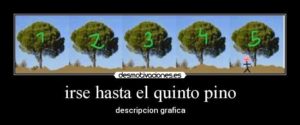It’s two-for-one day here on How to Learn Spanish!

We’re going to cover two phrases in one Learn Spanish for Real post, primarily because they both mean the same thing: something is really far away.
For the curious, this is from the Sochi Winter Olympics, a photo made famous by BBC correspondent Steve Rosenberg. One stall, two toilets, great success!
“Estar en el quinto pino”
This phrase originates from the 18th century in Spain when Felipe V ordered the five pine trees be planted along what was then Madrid’s largest and grandest boulevard: el Paseo del Prado (“paseo” means promenade in this context and “prado” means “meadow”, for the curious). They were spaced very far apart with the first one at the very center of Madrid, at the start of the Paseo del Prado near Atocha, and the fifth one ending up at the very outskirts of the city.
By the 19th century the pines had fully grown to great size and, being on the main boulevard, were frequently used as reference points and meeting places. Additionally, in this time period public affection or even unchaperoned meetings between young lovers was frowned upon, and so the fifth pine became a popular meeting spot for lovers who wanted to be able to hold and kiss each other away from the disapproving eyes of the public. If I had to guess, I’d also bet it was popular as a meeting spot for adulterous couples and others who, for various reasons, couldn’t afford to be seen together.
So yes, it was basically a popular necking spot for the kids of 1800’s Madrid (I’m linking to the UD definition for that as it’s an American term, and an old-fashioned one at that, I know some of you won’t be familiar with).
It was known for being a place that was very far away from just about everything else of any interest, and so the expression “estar en el quinto pino” came to simply mean “far away”. “Estar” means “to be” in the sense of location, “en” means “at” in this case (it can also mean “in”), “quinto” is “fifth”, and “pino” is a pine tree.
Thanks to Secretos de Madrid and Expresiones Españolas para Erasmus en Apuros for their writings on this subject (go there and read those to get a bit more detail and some Spanish practice).
“Donde Cristo perdió la zapatilla”
This one’s a lot tougher to explain. I really did some digging around to try to find the origin and came up with nearly nothing. The best I could find was this page saying that it alluded to Christ’s constant treks across the desert of Judea and that if he lost a shoe there at some point then it must have been God knows (literally!) where out in the middle of the desert.
It just means that something is very far away or out in the middle of nowhere, that’s it. “Donde” means “where”, “Cristo” is Christ, “perdió” is the 3rd person preterite of “perder“, and “zapatilla” is “slipper/shoe”.
There are many variations of this expression, including but not limited to: “donde Cristo perdió la sandalia”, “donde Cristo perdió el mechero”, “donde Cristo perdió la chancla”, and “donde el diablo perdió el poncho”. An exhaustive list can be found in the following amusing discussion on the WordReference Forums entitled “Qué más perdió Cristo?” (“What else did Christ lose?”).
Well that was fun. Did you have fun? I had fun. Tell me about how much fun you had in the comments (and would like me to write about in the future), also… If you thought the above was at all useful and you want to learn (or are learning) Spanish, please give me a chance and read what I have to say about my book below! Thank you so much for checking out my blog and I hope you’ve enjoyed my writing.
I learned to speak conversational Spanish in six months using TV shows, movies, and even comics: I then wrote a book on how you can, too
I have a whole method and a book I wrote about it called The Telenovela Method where I teach you how to learn Spanish from popular media like TV shows, movies, music, books, etc. that you can all find online for free. It was the #1 new release in the Spanish Language Instruction section on Amazon for nearly a month after it came out and currently has 17 reviews there with a 4.9/5 stars average. It’s available for $7.99-$9.99 for the e-book version depending on who you buy it from (Kindle version on Amazon is now $7.99) and $16.99 for the paperback (occasionally a bit cheaper, again, depending on who you buy it from).
It’s currently available in both e-book and paperback from:
Cheers,
Andrew








